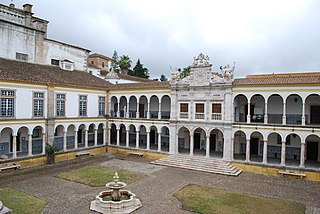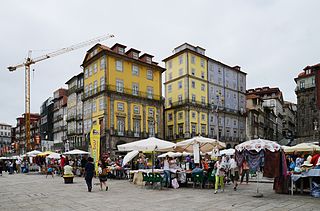
Afonso I, also called Afonso Henriques, nicknamed the Conqueror and the Founder by the Portuguese, was the first king of Portugal. He achieved the independence of the County of Portugal, establishing a new kingdom and doubling its area with the Reconquista, an objective that he pursued until his death.
UPT and Upt can stand for:

The University of Évora is a public university in Évora, Portugal. It is the second oldest university in the country, established in 1559 by the cardinal Henry, and receiving University status in April of the same year from Pope Paul IV, as documented in his Cum a nobis papal bull. Running under the aegis of the Society of Jesus meant that the university was a target of the Marquis of Pombal's Jesuit oppression, being closed down permanently in 1779 and its masters either incarcerated or exiled.

Paço de Arcos is a locality of Oeiras. In 2013, the parish of Paço de Arcos merged into the new parish Oeiras e São Julião da Barra, Paço de Arcos e Caxias. The population in 2011 was 15,315, in an area of 3.39 km². It was elevated to town by a decree on December 7, 1926.

The Estádio D. Afonso Henriques is a football stadium in the city of Guimarães, Portugal.

Dulce of Aragon also called Dulce of Barcelona, was Queen of Portugal as the wife of King Sancho I of Portugal.
InfanteHenrique João Nuno Miguel Gabriel Rafael of Braganza was claimant to the courtesy titles of Infante of Portugal, as the youngest son of Duarte Nuno, Duke of Braganza, claimant to the defunct throne of Portugal, via the Miguelist branch of the House of Braganza. He also claimed the title of Duke of Coimbra.

The University of Pittsburgh at Titusville is a state-related college in Titusville, Pennsylvania. It is a two-year campus of the University of Pittsburgh that provides associate degrees and pre-professional tracks with the potential to transfer students to other programs for baccalaureate degrees. In the fall of 2020, Pitt-Titusville converted its academic programs into the University of Pittsburgh at Titusville Education and Training Hub. This program incorporates three entities into UPT: Northern Pennsylvania Regional College (NPRC), the university's Swanson School of Engineering, and Manchester Bidwell Corporation.

Duke of Lafões is a Portuguese title of nobility created under the decree of February 17, 1718, of King John V of Portugal and granted to his nephew, Dom Pedro Henrique de Bragança, the building force behind Palacio do Grilo and first son of Infante Miguel de Bragança, the latter an illegitimate son of King Peter II of Portugal and Anne Armande Pastre de Verger. Pedro's mother, Luisa Casimira de Sousa Nassau e Ligne was the first to use this title. The title was later passed on to his brother, João Carlos de Bragança e Ligne de Sousa Tavares Mascarenhas da Silva, the most famous Duke of this title.
Portugal has a system of orders, decorations, and medals as a means of honouring individuals for personal bravery, achievement, or service to Portugal.

The Stock Exchange Palace is a historical building in Porto, Portugal. The palace was built in the 19th century by the city's Commercial Association in Neoclassical style. It is located in the Infante D. Henrique Square in the historical centre of Porto, designated World Heritage Site by UNESCO.

The Order of Prince Henry is a Portuguese order of knighthood created on 2 June 1960, to commemorate the quincentenary of the death of the Portuguese infante Prince Henry the Navigator, one of the main initiators of the Age of Discovery. Minor reforms of the constitution of the Order occurred in 1962 and 1980.

Primary school education in Cape Verde is mandatory between the ages of 6–14 and free for children ages 6–12. In 1997, the gross primary enrollment rate was 148.8%. Primary school attendance rates were unavailable for Cape Verde as of 2001. While enrollment rates indicate a level of commitment to education, they do not always reflect children's participation in school. Textbooks have been made available to 90% of school children, and 90% of teachers have attended in-service teacher training. Its literacy rate as of 2010 ranges from 75 to 80%, the highest in West Africa south of the Sahara.

The Casa do Infante, or alternately as the Alfândega Velha, is a historical house in the civil parish of Cedofeita, Santo Ildefonso, Sé, Miragaia, São Nicolau e Vitória, in the municipality of Porto, in northern Portugal.

The Ribeira Square is a historical square in Porto, Portugal. It is included in the historical centre of the city, designated World Heritage by UNESCO.
Diogo de Teive was a maritime captain and squire to the House of Infante D. Henrique (1394-1460) during the Portuguese period of discovery. Following his exploration into the western Atlantic in the area of Newfoundland, in 1452 he discovered the western islands of the archipelago of the Azores: for his efforts he was appointed Donatary for the islands of Flores and Corvo.

The County of Portugal refers to two successive medieval counties in the region around Guimarães and Porto, today corresponding to littoral northern Portugal, within which the identity of the Portuguese people formed. The first county existed from the mid-ninth to the mid-eleventh centuries as a vassalage of the Kingdom of Asturias and the Kingdom of Galicia and also part of the Kingdom of León, before being abolished as a result of rebellion. A larger entity under the same name was then reestablished in the late 11th century and subsequently elevated by its count in the mid-12th century into an independent Kingdom of Portugal.
Fernando de Castro was a 15th-century Portuguese nobleman, diplomat and military figure. Fernando de Castro was the 1st Lord of Paúl de Boquilobo. He was a member of the royal council of John I of Portugal, and governor of the household of Prince Henry the Navigator.

The Infante Dom Henrique Bridge, commonly known as Infante Bridge, is a road bridge across the Douro River in Greater Porto, Portugal. The bridge is upriver from the Dom Luís I Bridge and downriver from the Maria Pia Bridge.














